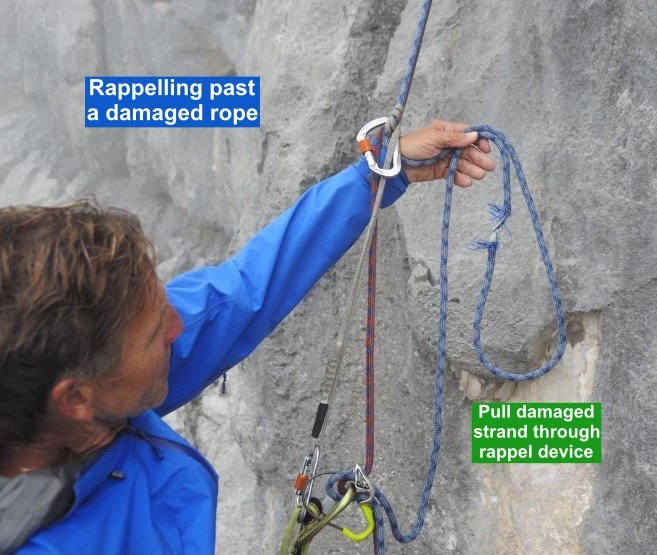How do you rappel past a damaged section of rope?
Note - This post discusses techniques and methods used in vertical rope work. If you do them wrong, you could die. Always practice vertical rope techniques under the supervision of a qualified instructor, and ideally in a progression: from flat ground, to staircase, to vertical close to the ground before you ever try them in a real climbing situation.
Photos and method in this post are from Walter Britschgi, @walterbritschgi, shared with permission.
Scenario: you’re rappelling down through some nasty loose rock.
During your rappel you kick some rocks loose.
One of them unfortunately hits your rope, damaging one strand.
Now, you need to finish your rappel, get past the damaged section of rope, and tie it off, so it's secure enough for you and your partner to continue going down.
How can you do this?
(Yes, it's a very unlikely situation, but if it happens, you’ll need to deal with it.)
Bigger picture, it's good practice when rappelling to look DOWN and be aware of what’s below you. Is the rope stuck in a crack? Are the ends on the ground? Do you need to pendulum to reach the next anchor? Or, in the case below, is the rope damaged?
Here’s another scenario where someone had to deal with this. (From Instagram. Sorry I don’t have the original post to offer credit.)
Here’s one method to rappel past a damaged section of the rope.
Stop a short distance above the damaged rope strand.
Go hands-free on your rappel. Let your autoblock take your weight. Tie a hard back up/catastrophe knot a few meters below in both strands, and clip it to your belay loop with a locker.
Add a friction hitch above your rappel device. A single length 60 cm sling is a good length for this.
Clip the friction hitch to your belay loop with a locker. Feed a little rope through your device until your weight goes onto the friction hitch.
Key move: Slide only the damaged strand of rope through your device. Once it's above you, tie a bight knot (overhand is fine) to isolate the damaged part of the rope.
Now is where it can get a little physical. Pull the slack rope through your device so you can reload both strands equally. (If it's really steep, you may need to add a second friction hitch as a foot loop.)
Put your weight back on your device, remove the friction hitch, untie the hard backup knot, and continue your rappel.
YO! Practice this on a staircase before you ever try it for real outside!
Check out the photo sequence below, courtesy of Walter Britschgi. (Note: recommended hard backup knot isn’t shown.)
Image: @walterbritschgi
Image: @walterbritschgi
Image: @walterbritschgi
Image: @walterbritschgi
Image: @walterbritschgi
Questions, random ideas, FAQ about rappelling past a damaged section of rope. . .
Why not reach down below you, tie a knot, and then pass it?
Sure, you could do that. That technique is closely related to this one. However, that requires that you actually remove both strands of rope from your device and reattach it below the knot, which might slightly increase your risk and the chances of you dropping your device. With this method, you pass the damaged strand through your device and then tie the knot. This means both strands of rope stay in the device the entire time. Set up a controlled practice space to try both of these and see which one you like better!
Keep in mind, it’s extremely unusual for most recreational climbers to ever have to pass a knot.
This example is when you start down a rappel without the expectation of having to pass a knot. You can imagine how rare that would be!
A more typical case of passing a knot on a single strand rappel might be if for some reason you need to tie two ropes together to get down a long distance, fast, like an injury or accident, incoming thunderstorm, whatever. (And yes, you might leave the ropes behind.) Or, when you’re big wall climbing maybe you fix a couple of ropes to a high point and then rap back down to your bivy or the ground.
For these cases of rappelling on a single strand, there are other techniques.
If you’re doing a standard double strand rappel and have a knot in one of the strands, there's no need to pass that knot at all.
You can tie the rope off and have everybody except the last person rappel on the strand of rope that doesn’t have the knot.
What about the last person? They have a few options.
You can secure the strand with the knot at the bottom anchor and have the last person do a counterbalanced rappel, read more about that here.
If you have small hardware at the anchors, you could also do a knot or carabiner block, rappel single strand, and use the strand with the knot as a pull cord.
Passing an existing knot is tricky and time-consuming, so it's good to know a couple of methods to avoid it if at all possible. If you're rappelling two strands of rope, you should never have to do it at all.







